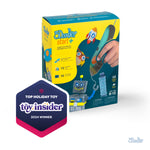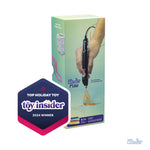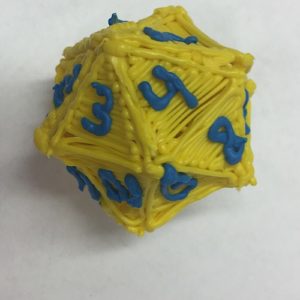Pentomino Puzzler (Geometry)
In this activity, students will work in pairs to create a set of 3Doodled pentominoes and then assemble them to solve the 6x10 rectangle. Pentominoes are tetris-like shapes that your students will enjoy designing and working with, as they're problem solving. The focus of this lesson is on the "Standards for Mathematical Practice," which compose the critical components of thinking and reasoning.

KnowledgeStudents haveunderstand the structure of dominoes as a shape made up of two squares attached.
understand the structure of trominoes as a shape made up of three squares attached edge to edge. *See Appendix.
understand the structure of polyominoes as a shape made up of any number of squares attached along their edges. *See Appendix.
had practice in rotating, sliding and flipping shapes.
had plenty of practice in using the 3Doodler. *This activity requires quite a bit of control.
understand the structure of dominoes as a shape made up of two squares attached.
understand the structure of trominoes as a shape made up of three squares attached edge to edge. *See Appendix.
understand the structure of polyominoes as a shape made up of any number of squares attached along their edges. *See Appendix.
had practice in rotating, sliding and flipping shapes.
had plenty of practice in using the 3Doodler. *This activity requires quite a bit of control.
ObjectivesStudents willlearn about the 12-pentomino shapes.
be able to recognize and identify the 12-pentomino shapes.
Verify experimentally the properties of rotations, reflections, and translations.
3Doodle a set of pentominoes.
use pentominoes to attempt to solve the 6 x10 rectangle puzzle.
learn about the 12-pentomino shapes.
be able to recognize and identify the 12-pentomino shapes.
Verify experimentally the properties of rotations, reflections, and translations.
3Doodle a set of pentominoes.
use pentominoes to attempt to solve the 6 x10 rectangle puzzle.
MaterialsStudents will need3Doodler (1 per pair)
scissors (1 per pair)
sandpaper or nail file (1 per pair)
Pentomino worksheet (1 per pair)
3Doodler (1 per pair)
scissors (1 per pair)
sandpaper or nail file (1 per pair)
Pentomino worksheet (1 per pair)
Lesson PlanInstructions
Step 1Assign 5-equal sized squares to each pair or students. Ask them to work with a partner to see how many different composite shapes they can create from these 5 squares connected edge to edge.
Step 2Display your tablet, laptop or computer screen on the board with the Pentomino worksheet to introduce the 12-pentomino shapes. Note that each pentomino is composed of 5 equal sized squares attached edge to edge. Practice recognizing and identifying each pentomino by name.
*See Pentomino worksheet in Resources.
Step 3State the goal: To create a 3Doodled set of pentominoes and use them to solve the 6 x10 rectangle puzzle. Note that there are 2,339 solutions to this puzzle, but that finding even one is extremely difficult.
Option: Display the 2,339 solution page. Don't worry, your students will not remember the solutions.
Solution Page
Step 4Optional: Work together as a group to try and solve a 6 x10 pentomino puzzle online at this page.
Note that pieces can be flipped (reflection), slid (translation) or turned (rotation). These are called "transformations."
Step 5Optional: Assign one tablet, laptop or computer per pair. Give students time to practice solving the 6 x 10 puzzle online Here
Step 6Model how to use the Pentomino worksheet stencils and 3Doodler to create a set of pentominoes. Then use 3Doodled pentominoes to solve the 6x10 puzzle on the Pentomino worksheet mat. Note that it is important to trace stencils as accurately as possible, so that pentominoes fit together neatly. Stray strands or uneven edges can be trimmed with scissors or filed down with sandpaper.

![]()
![]() Step 7
Step 7Hand out Pentomino worksheet and 3Doodlers. Circle the room to assist and assess as students work.

![]()
![]()
Assign 5-equal sized squares to each pair or students. Ask them to work with a partner to see how many different composite shapes they can create from these 5 squares connected edge to edge.
Display your tablet, laptop or computer screen on the board with the Pentomino worksheet to introduce the 12-pentomino shapes. Note that each pentomino is composed of 5 equal sized squares attached edge to edge. Practice recognizing and identifying each pentomino by name.
*See Pentomino worksheet in Resources.
State the goal: To create a 3Doodled set of pentominoes and use them to solve the 6 x10 rectangle puzzle. Note that there are 2,339 solutions to this puzzle, but that finding even one is extremely difficult.
Option: Display the 2,339 solution page. Don't worry, your students will not remember the solutions.
Solution Page
Optional: Work together as a group to try and solve a 6 x10 pentomino puzzle online at this page.
Note that pieces can be flipped (reflection), slid (translation) or turned (rotation). These are called "transformations."
Optional: Assign one tablet, laptop or computer per pair. Give students time to practice solving the 6 x 10 puzzle online Here
Model how to use the Pentomino worksheet stencils and 3Doodler to create a set of pentominoes. Then use 3Doodled pentominoes to solve the 6x10 puzzle on the Pentomino worksheet mat. Note that it is important to trace stencils as accurately as possible, so that pentominoes fit together neatly. Stray strands or uneven edges can be trimmed with scissors or filed down with sandpaper.

Hand out Pentomino worksheet and 3Doodlers. Circle the room to assist and assess as students work.

Wrap Up
Assessment
Possible Extensions
Vocabulary
flip - a transformation creating a mirror image of a figure on the opposite side of a line. A flip is also called a reflection.
slide - a transformation that slides a figure a given distance in a given direction. A slide is also called a translation.
transformation - a general term for four specific ways to manipulate the orientation of a point, a line, or shape.
turn - the transformation that occurs when a figure is turned a certain angle and direction around a point. A turn is also called a rotation.
Educational Standards
Make sense of problems and persevere in solving them.
Students will understand the meaning of the 6x10 pentomino problem and then attempt various configurations of pentomino pieces to attempt to solve it.
Model with mathematics.
Students will create a set of 3Doodled pentominoes to attempt to solve the 6x10 puzzle in the real world rather than online.
Use appropriate tools strategically.
Students will use 3Doodlers to explore and deepen their understanding of pentomino concepts.
Attend to precision.
Students will use precision in the design of their petomino pieces, as well as their communication about pentomino solutions.
Look for and make use of structure.
Students will look closely to discern a pattern or structure within pentomino solutions.
Engineering Design Define a simple design problem reflecting a need or a want that includes specified criteria for success and constraints on materials, time, or cost.
Students will create a series of jumping circles based on a set of criteria.
Engineering Design Generate and compare multiple possible solutions to a problem based on how well each is likely to meet the criteria and constraints of the problem.
Students will make observations about mathematical relationships based on solutions to multiple Jumping Circles.
Decompose (break down) a larger problem into smaller sub-problems with teacher guidance or independently.
Students will break down the larger problem of solving a 6x10 pentomino puzzle into smaller tasks: identifying and recognizing pentominoes, practicing the 6x10 puzzle online, constructing a 3Doodled set of pentominoes and using them to attempt to solve the 6 x10 puzzle on a mat.
Use technology to seek feedback that informs and improves their practice and to demonstrate their learning in a variety of ways.
Students will use the 3Doodler to create a concrete model of a pentomino set. Students will use these pentominoes to attempt various solutions to the 6x10 puzzle.
Exhibit a tolerance for ambiguity, perseverance and the capacity to work with open-ended problems.
Students will demonstrate willingness and competency within an open-ended task with more than one possible outcome.
Create original works or responsibly repurpose or remix digital resources into new creations.
Students will use a 3Doodler to design a set of pentominoes.
Use collaborative technologies to work with others, including peers, experts or community members, to examine issues and problems from multiple viewpoints.
Students will use a 3Doodler with a partner and work together to attempt to solve the 610 pentomino puzzle.





